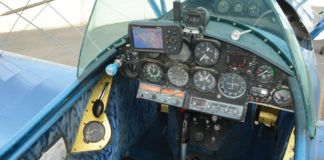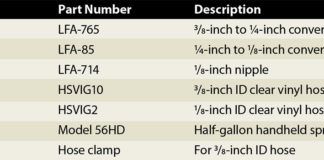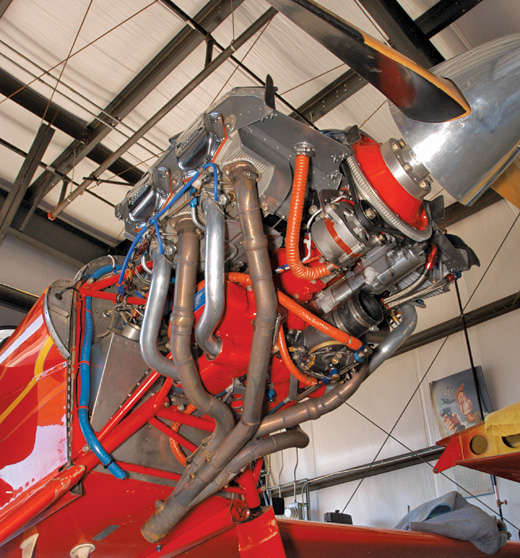
Avgas, you may have noticed, has gotten expensive. If you’re building an airplane or majoring an engine, the bite at the pump is sure to factor into your thinking. What can you do to increase the efficiency of the typical Continental or Lycoming?
I spoke with representatives of three of the best-known performance engine shops—Aero Sport Power, Barrett Precision Engines and Ly-Con Aircraft Engines—and took away many suggestions to increase fuel economy, though not all make sense in the real world.
The Biggest Factor
By far the single biggest factor in gas consumption is you, the pilot. The quickest, easiest, most effective way of saving fuel is the way you operate the airplane, especially the black knob. Simply pulling back on the throttle—in other words, slowing down—saves more gas than anything else.
Combining less aerodynamic drag with reduced throttle is even better. The best way of doing that is flying at a higher altitude. There’s not much you can do on a half-hour burger run, but if you’re traveling farther, flying up at some significant portion of 10,000 feet automatically closes the throttle via reduced manifold pressure, thereby reducing aerodynamic drag.
The holy grail of saving fuel is to run lean of peak; 50° F lean of peak is notably more economical than running 50° rich of peak. And when it comes to building an engine for today’s realities, setting it up to run lean of peak is a smart investment. That means making all cylinders as equal as possible and having quality engine monitoring to measure the exhaust-gas temperature (EGT) and cylinder-head temperature (CHT) on all cylinders. It also means accepting a small speed penalty. (See Sidebar below)
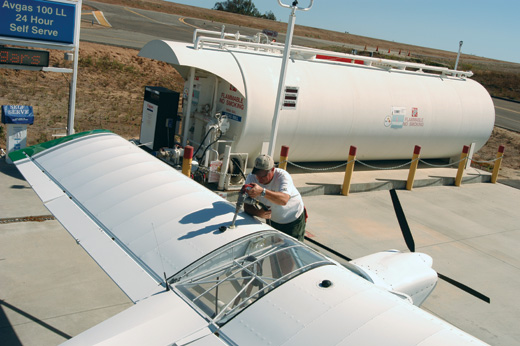
As fuel makes up a greater percentage of flying budgets, the opportunities to invest in fuel efficiency modifications grow. If your engine can run mogas and you can find it without ethanol, you’re way ahead of the game. If married to 100LL, take advantage of its excellent anti-knock capabilities to build cylinder pressure and gain mileage.
Compression Ratio
The working fluid in a piston engine is air. Fuel is added and burned to raise the pressure of the air trapped in the cylinders, and thus doing the work of turning the propeller. The fundamental goal then is raising the cylinder pressure within the mechanical limits of the engine and the burning characteristics of the fuel without wasting any of the fuel you’re trying to burn. (See the April 2012 KITPLANES®, “Compression Ratio and Horsepower” sidebar.)
A direct method of increasing the cylinder pressure is to raise the engine’s compression ratio. Typical stock compression ratios in Lycoming and Continental engines are 6.5:1 to 8.5:1, but the Experimental community has a whole subset of airshow performers, racers, hot rodders and efficiency freaks who consider 10:1 normal and 12:1 racy. At least for the popular parallel-valve Lycoming 360/540 engines 10:1 is “now run of the mill” at Ly-Con, says principal Ken Tunnell, and Alan Barrett of Barrett Precision Engines notes his typical RV customers, “don’t need a radical engine…so they bump half a point to 9:1 and they get 6 to 8 more horsepower out of it…. It doesn’t affect TBO and [you] can run 9:1 on high-end autogas.”
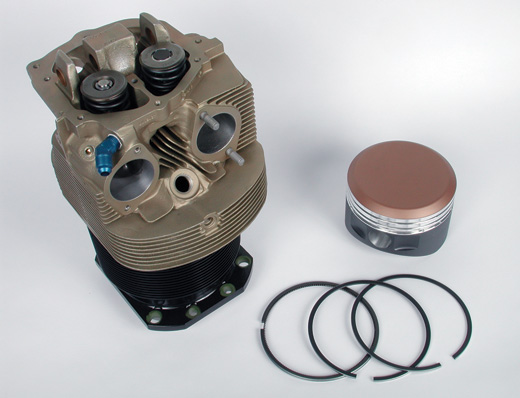
Raising compression will also raise CHTs slightly, especially at takeoff power. That’s one reason Ly-Con offers alodined cylinder heads, as they run perhaps 25° F cooler without paint on them. The piston has been heat-barrier and low-friction coated as well.
In properly built and operated engines (a phrase not to be glossed over) compression ratios up to 10:1 have proven durable, and a surefire efficiency builder yielding 3 to 5 hp per parallel-valve Lycoming cylinder. In practice, this means more sea-level horsepower for faster climbs and smaller power losses at altitude. Yes, it takes more fuel to make the extra horsepower down low, but it’s compensated by the faster climb to fuel-saving altitudes. Alternately, you can throttle back to stock power figures that are obtained with reduced fuel burns on those low-altitude breakfast runs.
The main danger of higher compression ratios is a reduced margin before detonation develops. Luckily the excellent detonation protection of 100LL fuel means “knocking” is not an issue at 10:1 in the 360/540 cylinder. If octane is lowered in future fuels however, a high-compression engine can still be safely operated simply by limiting manifold pressure below, say, 5000 feet density altitude.
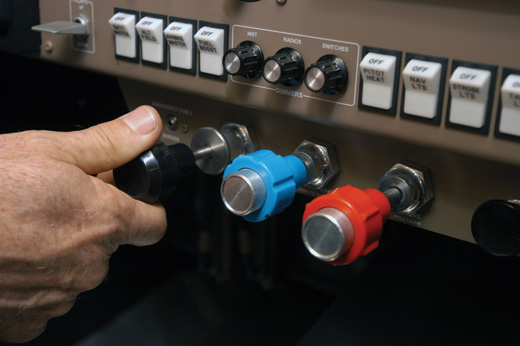
How you handle the black, blue and red knobs still plays the biggest part in fuel efficiency and costs the least to implement. As Alan Barrett put it, “If you’re worried about fuel economy, you have to learn to pull the throttle back.”
Breathing Mods
Another strategy is to increase the mass of air passing through the cylinders by increasing the engine’s breathing—its capacity to move air. This is a broad subject covering everything from the air filter to the intake manifold to the exhaust pipe outlet, but we’ll divide our discussion between internal engine mods and intake/exhaust system considerations.
In the core engine two techniques are commonly employed to improve breathing: porting and multi-angle valve jobs. Of the two, the valve job is the more effective. Lycoming, especially, ships its cylinders with just one angle cut into the valve seats. All three engine shops improve this critical airflow area by cutting three angles into the seat to more gently bend the air into and out of the cylinder, and while none like to cite a hard number because much depends on what valve seats you’re talking about, gains of 2 to 4 hp per cylinder can be depended upon.
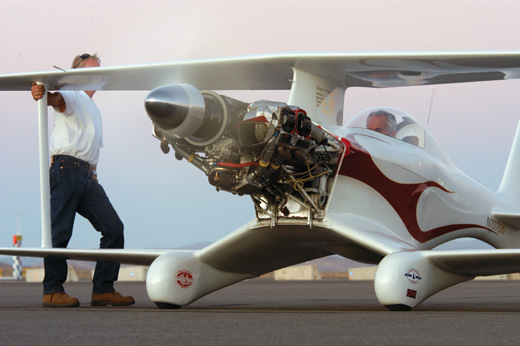
Engine efficiency can be had one of two ways: speed or economy. To wit, Tom Aberle runs up Phantom’s full-race IO-360 Ly-Con Lycoming. It laps Reno at an average 261 mph burning 23 gph at 3600 rpm, but can also be throttled back for a 200+ mph cruise at 8.25 gph at 2600 rpm. Don’t you think aerodynamics are playing a large role at these speeds, too?
Porting—detailing the intake and exhaust ports by some combination of smoothing and re-shaping—is highly effective because the typical aviation engine’s ports are too large to begin with. That limits porting effectiveness to reducing turbulence by smoothing the port walls, plus some airflow gains by massaging the “short turn radius” along the floor of the port. Ly-Con’s extensive racing and airshow exhibition engine building experience has made it more bullish on the practice. That, and only Ly-Con has a CNC machine that more easily duplicates precisely the same port in every cylinder head. It helps make the ports identical cylinder-to-cylinder, a boon to a smoother, more even-running engine that supports precise leaning.
Other characteristics of the legacy cylinders in the typical Continental and Lycoming defy field remedies. A major issue is big, open combustion chambers that don’t mix the air/fuel charge well, says Alan Barrett. The cure is to redesign the chamber in a new generation of replacement cylinders, something that may be afoot in more than one engine shop. So far Barrett Precision Engines seems ahead of the curve with its display of an exciting new Lycoming 360/540 parallel-valve cylinder last July at AirVenture. The new jug is no copy of the existing cylinders, but an extensive update that addresses the porting and chamber issues, and should offer a meaningful jump in efficiency (power and fuel consumption) when finally in production. This could be a major development for Experimental engines.
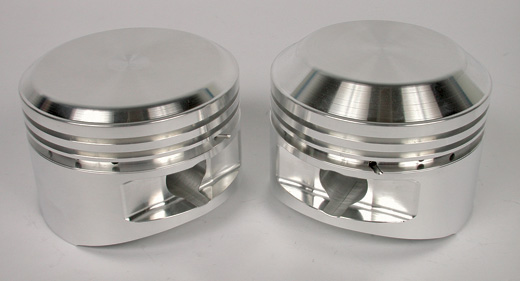
High-compression pistons are readily available in mild-to-wild ratios. This pair is Ly-Con’s 7.5:1 and 10:1 offering for the venerable O-200 Continental. Despite the tall domes, piston weight is typically identical, so rebalancing the engine isn’t necessary for future compression ratio changes.
Aero Sport Power proprietor Bart LaLonde mentioned another well-known breathing tactic: higher-ratio rocker arms. This increases the valve lift (without monkeying with the camshaft), along with accelerating the valves faster off and on their seats. There’s definitely an efficiency improvement with this, but it’s small and takes too long to pay off in fuel saved. At $2000 for 2 or 3 hp, it’s the sort of detail racers find useful.
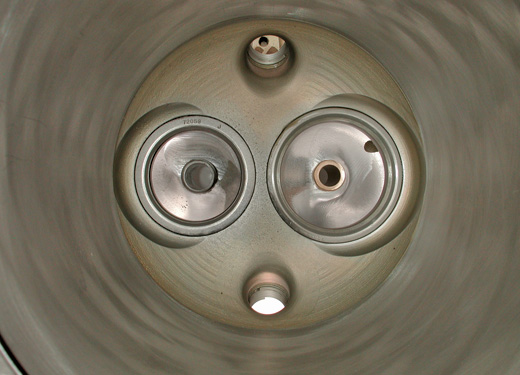
Large and open, the typical Lycoming or Continental parallel-valve combustion chamber does not promote beneficial mixing of the air/fuel mixture, hurting efficiency. Only a new generation of cylinders will cure this issue.
Increased Displacement
It may go against conventional wisdom, but increasing the displacement on the 360 Lycoming has worked for Aero Sport Power. LaLonde has worked with ECi to offset grind the rod journals on 360 crankshaft forgings to arrive at a longer stroke crankshaft, but with a stock rod journal diameter. This allows stock connecting rods and bearings while yielding 375 cubic inches.
As LaLonde said, “We were expecting a power increase in proportion to the displacement increase, but we actually get a little bit better than that.” There are several explanations, from beneficial rod/stroke ratio effects, to reduced cruise rpm, to the larger displacement asking more of the too-large Lycoming cylinder-head ports and thus getting more efficiency from them. Again, the main benefit is increased torque in an engine that weighs the same, but throttled back to stock power the gain should come as a small efficiency increase. Aero Sport Power rates the 375 at 195 hp on mogas with 8.0:1 pistons and 205 hp burning 100LL with 9.6:1 pistons.
Conceptually this is similar to Lycoming’s IO-390 series, save that it uses larger bore 580 cylinders (with too-large ports) instead of the Aero Sport Power 375’s longer stroke.
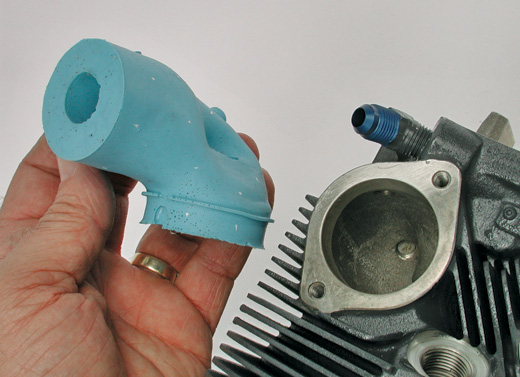
This blue latex port mold illustrates the shape of a 360/540 Lycoming intake port. Of note is the sharp 90° inside bend just above the valve seat. It’s asking a lot of an air/fuel mixture to whip around such a corner. Racers fill this area with weld and reshape it by hand, a powerful but high-dollar solution. Ignore the round hole at the outlet end of the port plug; it’s merely a latex-saving plug hole. The dimple at upper right denotes the valve guide.
Cold Air Intake
Outside of the core engine, attention to detail in getting air into and out of the engine pays off. Ram air intakes with gentle radius entries are normally thought of as power builders, but they are really more efficient. So with them, pulling the power back to stock levels means a reduction in fuel burn. In other words, when building your engine cowling it’s worth the effort to sweat the airflow details.
Likely the single largest step, both financially and engineering-wise, in engine air management is fitting a cold air intake on fuel-injected engines. By notably reducing inlet air temperatures, a major improvement in efficiency and a larger detonation margin are gained. But it is pricey, so you’ll want to run your own cost-benefit analysis. Considering what is spent on instrument panels, maybe more of us should be considering this option.
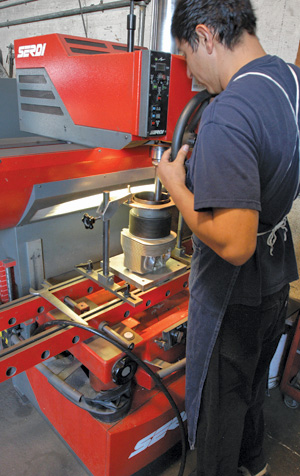
The gold standard in valve-seat machining is the Serdi head and seat machine. A spendy bit of kit, it’s accurate to 0.0001-inch and is the perfect way to put a three-angle valve job in factory cylinders.
Exhaust System
Experimental aircraft exhaust systems really only need a set of pipes that isn’t tied in a knot, but you’d be surprised at how many there are. It’s as if experimenters don’t consider the exhaust system until faced with making it fit around everything else—almost an afterthought.
A large issue is exhaust back pressure, a killer in air-cooled engines. Back pressure makes cylinder-head temps soar at high power settings, choking airflow and thus fuel economy. To reduce back pressure, use gentle bends and common-sense pipe joins.
The goal is to make each cylinder run evenly with its neighbors, so giving the front cylinders nice, free-flowing pipes, but stubbing the two rear cylinders into the first pair at right angles is not the best approach.
In practical terms, a simple manifold-type exhaust gets the hot air out of the cowling on four-cylinder engines, but a crossover system addresses some of the pumping fundamentals and is worth the effort. A four-into-one equal-length header is better yet, but to justify it you’ll need a tuned-up core engine with high compression, cold air intake and whatever else you can afford to give it. Plus the long, equal-length pipes of a proper header will require some brainpower to design and package, and even then header potency falls off with altitude in naturally aspirated engines because there’s so little air passing through the engine.
Six-cylinder engines in near-stock tune do OK with a good manifold system, and by “good” I mean stepped pipe diameters, mandrel bends, gentle curves and careful pipe joins. When the engine is highly tuned, a three-into-two tuned header is optimal, but six-into-one unequal-length systems have been popular because they are easier to build and more easily make smoke for showy types.
The bottom line with the exhaust is that for most engines simple will do, but this should not be an afterthought. It’s also an area where the engineering homebuilder can get as involved as desired, from buying a complete system off-the-rack to welding the bends.
Friction Reduction
Internal engine friction is a fuel waster and oil heater, so reducing it is always in the engineer’s mind. But friction calculations feature engine rpm, something our slow-turning engines don’t have much of, as a main actor. That’s likely why moly coatings didn’t figure prominently in the research for sport plane owners. Racers will think differently.
The one piece of remaining low-hanging friction fruit in the rebuild world is roller valve lifters. This is an emerging technology as a retrofit item, so the jury is still out, but the OEM engine makers have obviously made the commitment. Automakers say roller lifters reduce friction 3% in their higher-speed engines, so I’m not expecting huge avgas savings, but they will help and should be a game-changer in the fight against rusty cam damage.
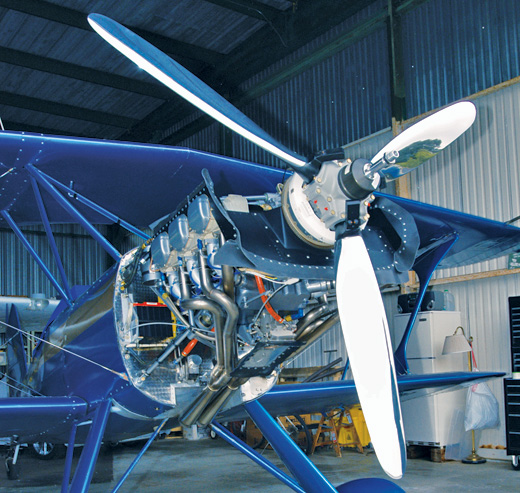
Constant-speed propellers offer efficiency gains, but like so many other improvements they often don’t pencil out, especially once maintenance costs are considered. For big power applications the advantages may be clear, but the fixed pitch-versus-constant speed debate among Van’s RV owners will likely never be resolved.
Fuel Injection
While not the state-of-the art stuff in your car, legacy aviation fuel-injection systems found on Continentals and Lycomings are proven fuel savers. How much they save depends on how poor the mixture distribution is with the carb intake that’s being replaced, but at the 180-hp level, anecdotal evidence suggests about half a gallon per hour better with fuel injection. The largest benefit is better fuel distribution among the cylinders, which is possible to tune via shuffling or substituting individual injector nozzles, a la General Aviation Modifications, Inc. (GAMI). In practical terms, fuel injection is the enabling technology for running lean of peak. Yes, carbureted engines can run lean of peak, but injected engines do the trick better.
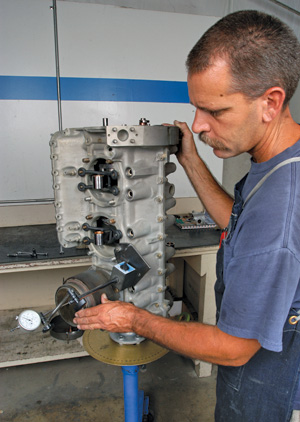
Without attention to basics such as accurate machining and diligent assembly, you’ll never have an efficient engine. Here Bruce Jobe at Ly-Con confirms the camshaft timing, just one of many steps that make the difference between a so-so and a sweet engine.
Where aviation fuel-injection systems are left wanting is that they are low pressure and therefore squirt a stream of fuel rather than blow a more desirable mist of tiny droplets. Plus, they aren’t timed to the intake valve opening in the first place, much less spray that stream directly into the cylinder. That said, if you’re currently carbureted and in the market for an engine overhaul, moving to injection is the foundation for running lean of peak in a meaningful way. Cost is an issue, as there is the injection system, a boost pump and minor plumbing to buy. But with some parts scrounging this should be a long-term, cost-effective improvement at today’s fuel prices.
If you’re starting from scratch, there are aftermarket fuel-injection systems to consider. LaLonde at Aero Sport Power understandably champions the automotive-like Eagle EMS sequential system, for example, but price is a consideration.
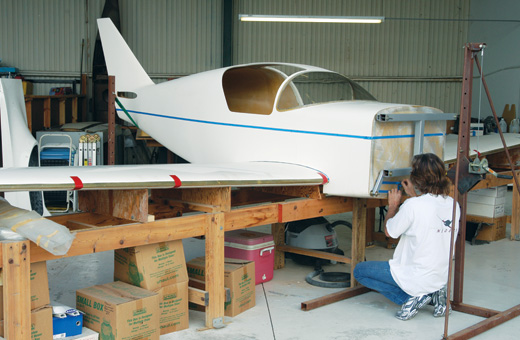
It’s never too early to start thinking about how to improve your homebuilt’s engine efficiency. Andy Paterson doesn’t even own an engine yet for his Glasair project, but is already marking the lower firewall for modification to accept tunneled cooling and exhaust exits.
Electronic Ignition
Want to start a fight? Start talking electronics among pilots and engine builders. There are good reasons for this, not the least of which is the phrase “electronic ignition,” which has become a catch-all label for a smorgasbord of very different ignition systems on the market. Some of these do quite different things and need to be addressed on an individual basis. Also, when compared to automotive practice, standalone aviation electronic ignitions are just part of a comprehensive engine-management system. The aviation equivalent would control the fuel, ignition, cam timing, turbo and propeller, but there’s nothing like that available.
The truth is, there is still plenty of good in a pair of magnetos on engines that rarely run outside of a 400-rpm-wide window, especially if you already own the pair on your engine. Barrett and Ly-Con are particularly content to run mags on their typical Experimental engines. Both Alan Barrett and Loren Lemen (of Ly-Con) cite the magneto’s long spark duration compared to the e-ignition’s blazingly quick discharge, and both have experienced the e-ignition’s maddeningly unpredictable ability to boot the ignition timing out of the ballpark in certain corners of the operating envelope.
As for giving the pilot another twiddle knob connected to the ignition timing as some e-ignitions do, be careful. Juggling the throttle, prop rpm, mixture and ignition timing is not for the neophyte, even more so with a higher compression ratio at sea level air densities. It’s what Full Authority Digital Engine Control (FADEC) engine management computers are for.
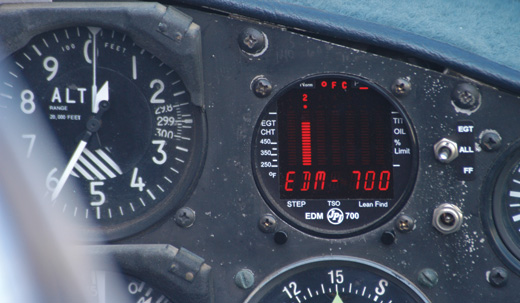
A good engine monitor is all of the fuel efficiency budget many pilots can muster, but that’s still a bunch. The accuracy and volume of information an engine analyzer such as the popular JPI EDM 700 provides is crucial to efficient engine operation, especially lean of peak.
Of course, it is the ability to vary the spark timing that is electronic ignition’s big advantage. For fuel saving this is especially true when running lean at altitude, as Aero Sport’s LaLonde pointed out. Such conditions mean the air/fuel mixture is spread thin throughout the combustion chamber and burns more slowly. Advancing the ignition timing really helps power/fuel consumption in such conditions, and that’s exactly what most aftermarket electronic ignitions do. Some e-ignitions multi-strike (fire more than once per ignition event). This reduces misfires and can save a touch of fuel as well.
The trick with electronics is in the mapping—the software that controls when the spark fires. Roughly speaking, advancing the ignition timing raises cylinder pressure, but combined with higher-compression pistons that do the same, this can be too much of a good thing. Furthermore, because the ignition map is programmed into the system by its manufacturer, the typical owner/builder/pilot is flying blind on where the ignition is firing, and is not trained to know what is good or too much. Ultimately, determining where the detonation danger point lurks is far too complex and variable from engine to engine and day to day to give the engine builders warm fuzzies, hence the retreat to a static 25° of magneto timing.
There’s fuel economy to be had with electronic ignition, but possible detonation danger as well when combined with other efficiency improvements, especially high-compression pistons. Definitely coordinate with your ignition specialist and engine builder when assembling such a combination.
Spark Plugs
It’s a minor point, but Loren Lemen at Ly-Con also suggested the Champion REM37BY spark plug, if applicable to your engine. The extended nose on this plug was designed to reduce lead fouling, but it also seems to be a power builder thanks to the spark igniting a little deeper in the combustion chamber, and with slightly more exposure to the air/fuel mixture due to its more open electrode design. These characteristics should slightly reduce misfiring, especially when running lean.
A Good Start
This brief overview of where some fuel-economy efficiencies lay should get you started on more research. Ultimately, I believe you’ll find what all the pro shops repeatedly said: Once past a touch more compression ratio, the gains to be had are detail oriented, and some of the best details are the most basic. A fresh engine with good piston ring and valve sealing, running smoothly under the hands of an informed pilot, is the foundation for fuel efficiency.











